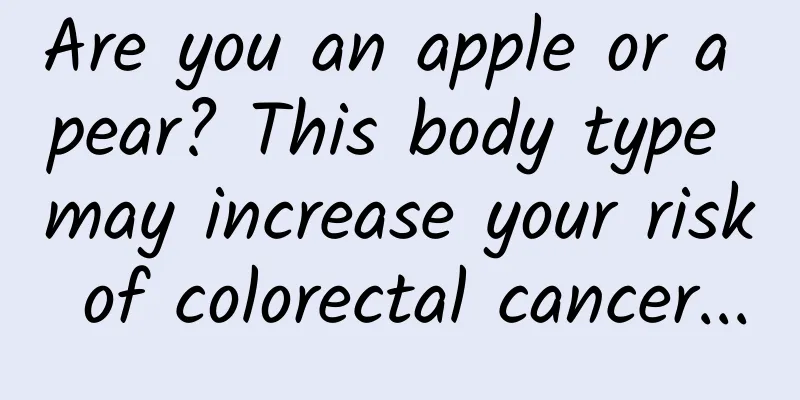Are you an apple or a pear? This body type may increase your risk of colorectal cancer...

|
Compiled by: Gong Zixin Colorectal cancer is the third most common cancer and the second leading cause of cancer death worldwide, with more than 1.9 million cases and nearly 1 million deaths in 2020. Evidence suggests that people who are overweight or obese (BMI ≥ 25 kg/m²) are at higher risk of colorectal cancer. Waist circumference, hip circumference, and waist-to-hip ratio represent surrogate markers of body fat distribution and, similar to BMI, have been shown to be associated with colorectal cancer risk but do not provide additional insights into colorectal cancer etiology or risk discrimination. Joint consideration of these anthropometric characteristics could provide information on the role of body size in cancer development and further understand how obesity subtypes are associated with differential colorectal cancer risk. Recently, a large international medical research team evaluated the body shape and genetic predisposition of tens of thousands of people to understand the risk of colorectal cancer. The results found that people with ordinary obesity and tall "apple" shaped bodies are more likely to develop colorectal cancer than people with other body shapes. The study was published in the journal Science Advances. In 2016, a group of researchers proposed a promising method for defining body size that could provide insights into the role of body size in the development of colorectal cancer. The method was derived from data from 170,000 individuals of European ancestry and was based on principal component analysis of six anthropometric traits (BMI, weight, height, waist circumference, hip circumference, and waist-to-hip ratio). In observational analyses, two distinct and orthogonal body types, characterizing general obesity and tall central obesity, were both strongly positively associated with colorectal cancer risk. These preliminary findings need to be replicated in different study populations and their potential causal basis evaluated. In addition, the development of colorectal cancer is characterized by various genetic and molecular changes, and body type may play a role through this unique but currently unknown molecular pathway. To this end, in this new study, the research team conducted a similar study in a larger population.
The study, the largest of its kind to date, involved collecting and studying data from 550,000 adults recorded in the UK Biobank. It also looked at genetic data from tissue samples collected from a further 800 donors. The research team found that tall people with an "apple" shape are more likely to develop colorectal cancer than people with other genetically encoded body types. An "apple" shape means that their genes tend to increase weight around the waist. The research team also found that tall, apple-shaped people tend to have more health problems related to the digestive system. In addition, ordinary obese people who are prone to becoming obese due to unhealthy diets are also more likely to develop colorectal cancer. The researchers noted that a generally obese body type was associated with gene expression patterns in tissues with a high proportion of neural cells, while a tall, centrally obese body type was associated with gene expression patterns in mesenchymal cells. This suggests that these two different body types may act through different downstream molecular pathways, which in turn affect colorectal cancer risk. The cover image and images within this article are from the copyright gallery (or copyright holder). Any reproduction or use may lead to copyright disputes. |
>>: Why doesn’t anyone drink “pig milk”? Is it because it tastes bad?
Recommend
What’s wrong with premature loss of deciduous teeth?
What is "early loss" of deciduous teeth...
What does chest calcification mean?
Breast problems are a prominent health issue for ...
Diagram of the body structure of a woman
There are many differences between women's bo...
Boiled mugwort leaves in water to treat cervical erosion
Mugwort is a traditional Chinese medicinal materi...
What are the moxibustion points for uterine cold?
Facing the problem of uterine cold, female friend...
Child growth and development assessment nutritional intervention
1. Characteristics of children's growth and d...
Where is the female colon located?
The duodenum of the human body is actually inside...
What foot bath can be used to treat gynecological diseases?
I believe that there are many people in the above...
How long after chocolate cyst surgery can I get pregnant?
Important reminder: After chocolate cyst surgery,...
Is it better to have 1 or 2 test tube transplants?
Many infertile men and women hope to have their o...
Can durian treat dysmenorrhea?
Durian itself produces a peculiar odor, so people...
Is pregnancy at 32 considered advanced maternal age?
Pregnancy at the age of 32 does not count as adva...
What are the differences between the three railway stations in Shanghai? Which one is the largest, Beijing or Shanghai?
After the liberation of Shanghai, finances were t...
Bleeding at 5 weeks of pregnancy
Bleeding occurs at five weeks of pregnancy. This ...
What causes vaginal dryness and painful intercourse?
A harmonious sex life is a prerequisite for every...









